Out There: October 2007 Archives
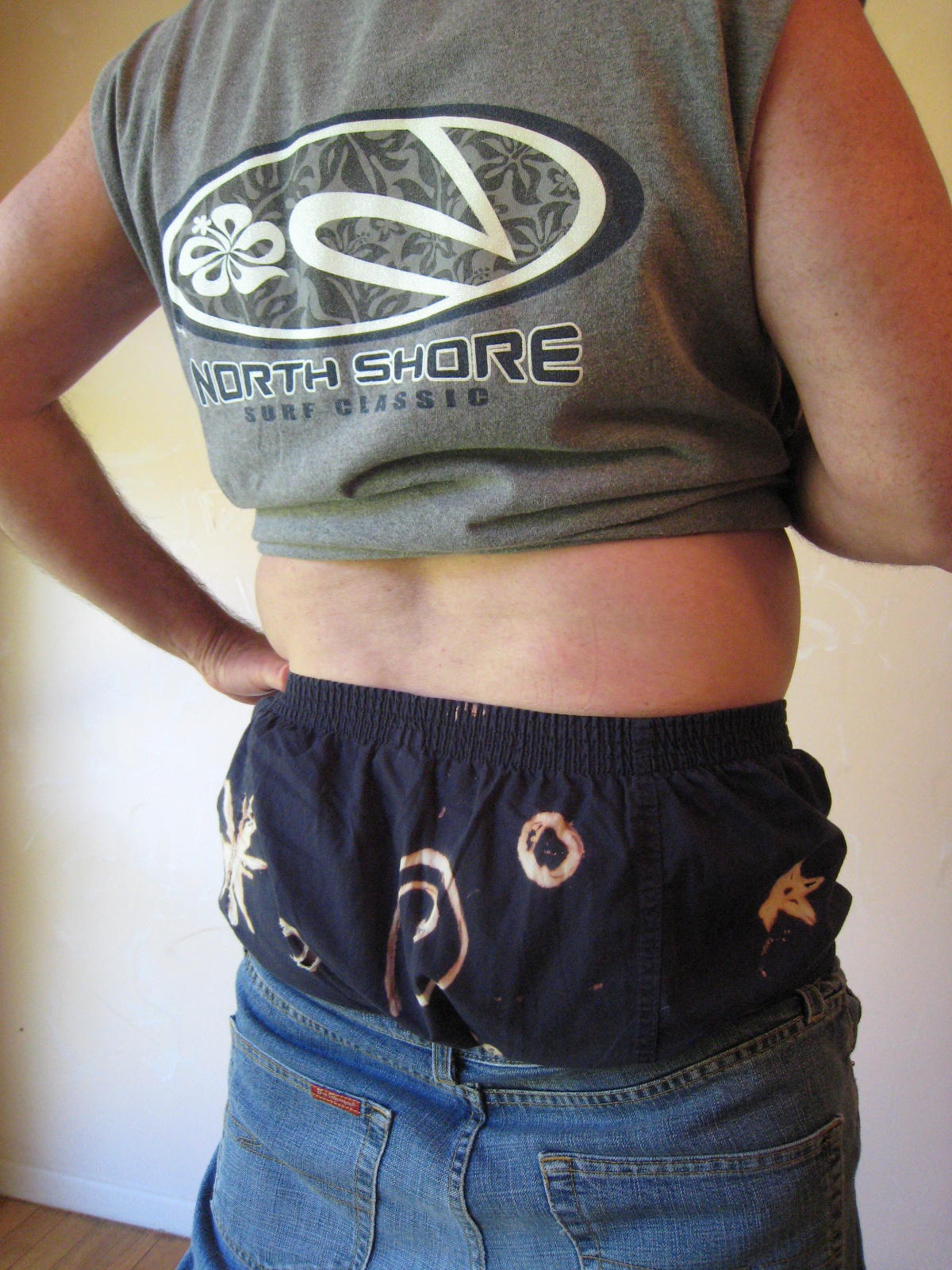
Anyone can "sag"
The Song Is Wrong
Any of you old enough to remember what wearing green once meant? Guys, I mean, white guys, white guys wearing green. You got laughed at and put down, in high school especially, because green meant you were "that way" -- except on St. Patrick's Day.

Actually, in real social life, wearing a red tie in certain pre-Stonewall urban circles was intended to signify exactly that, at least to those in the know.

It was the same as having your trouser cuffs tailored a bit high so your socks would show, like Fred Astaire's when he kicked up his heels. Inside-signals such as those, which had some small parlance across the usual barbed wire of race and class, were necessary when it was illegal and dangerous to be upfront about wanting to meet another man.
Apparently there's a brand new kind of gay-male dress code, one I had thought was just a species of hip-hop streetwear that's been around for a while. At least that's what a few folks in Dallas, Texas, think.
Some Dallasites have their knickers in a twist about boys who wear their pants so low that their shorts, or even their butt cracks, show. It's called sagging. Been going on for years; some saggers even wear their pants backwards. Dallas, home of the teenage plumber.
As reported, the story goes like this:
Parents and teachers were complaining that it was disrespectful and nasty for the community's young men -- most, but not all, of the boys in question being African American -- to be showing their shorts and even their bare rears (one report says the fashion ante was upped from clean boxers to dirty ones). Forget about the almost supernatural gravity-defying skill this phenomenon requires, especially for the skinniest. Constant "hitching" becomes part of the game.
As usual, making school rules and naggin' about saggin' got nowhere, because part of why kids do this in the first place is to annoy their elders. (Municipalities keep trying to ban the sag, at least in the Southeast, but they ultimately discover it's against the law to tell citizens what to wear.) Then a group called Hip Hop Government, with the support of a selfless deputy mayor, put up posters (donated by Clear Channel) in sag-infested Dallas neighborhoods that read: "Don't Be Lame, Elevate Your Game. Pullem' Up!"
Now comes the juicy, stupid part. Dallas gospel rapper Dooney Da' Priest (Dewayne Brown) got in on the act with a song that became the Dallas campaign's theme. Here's a line from his "Pull Your Pants Up": "You walk the streets with your pants way down low/ I don't know/ looks to me you on the down-low."
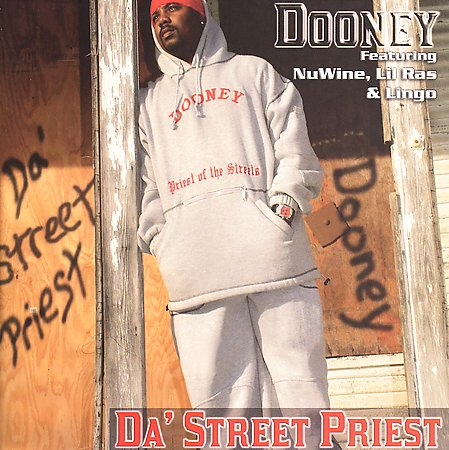
Dooney Da' Priest CD cover
Down low/down-low, a fashion pun! For those who have been away for a decade or three, being "on the down-low" or the DL initially referred to an ostensibly straight black guy having secret gay sex. But the term soon moved out of just-black use and widened to embrace any kind of concealed behavior, similar to the way you can now "come out of the closet" as a clandestine butterscotch lover, or anything at all.
In a recent interview, fashion historian Da' Priest explained that in prison, where saggin' got its start, wearing your pants below your cheeks meant you were a sexually available bottom (as it were).
Too bad that's just not true. It's the kind of misinformation that tries to use classic peer-pressure queerophobia to control youthful conformists conforming to whatever's unacceptable to the conformists in power. Because prisoners often are issued pants the wrong size and aren't allowed belts (from which inmates fashion in-house nooses), a make-it-work style and strut developed. Maybe Da' Priest can visit San Quentin, say, and clue in everyone there as to what saggin' really means. I'm sure they'll be thrilled to know.
Next posting moves from gender-fraught clothing to gendered fragrance and food: Sniffing Dirt, Tasting Sweat.
For an automatic alert when there is a new Out There entry, email jiweinste@aol.com.
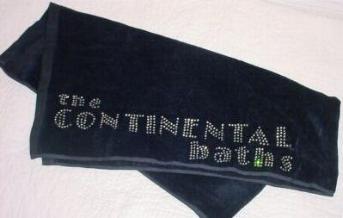
A terrycloth piece of cultural history (see below)
The New Old McNally
Soon there'll be no gay bars.
When I read that online and elsewhere last week, I wondered if the hypocrites in charge had managed to revive some sort of pre-Stonewall "no queers and booze in the same room" prohibition, a new blue law with lavender highlights.
But I was needlessly alarmed, because it was just entrepreneur.com predicting which businesses and products would vanish within a decade, like roll-film photo developers and tree-eating newspapers, because the need for them would be gone: "Gay men and women have been gaining greater acceptance in society. What used to be a hangout for people who felt unwelcome elsewhere is becoming less necessary."
Whew. Now my guy and I can walk into that cozy Laramie bar and snuggle over dirty martinis. Single same-sexers may cruise to their hearts' delight.
Out There predicts that those who wash blood off floors will always have a job.
Certainly many gay bathhouses, at least, have given up the ghost, but there's a four-letter reason for that. (Guess.) That doesn't mean there aren't all kinds of sex-fetish-dating-romance clubs to go to right now, at least in major metropolitan areas. Yes, Virginia, you can meet the love of your life in the strangest of places. But I just saw the just-opened Broadway revival of Terrence McNally's The Ritz, a mid-'70s farce about an out-of-town married man who hides from his murderous brother-in-law in a New York bathhouse that he doesn't know is gay -- oh, we have a Jack La Lanne in Cleveland, he says.
The playwright has been quoted as saying that he thought it wise to wait awhile before putting The Ritz on again, but enough time has passed.
What does that mean? No one's seroconverting anymore? We've forgotten our dead lovers, family, friends? The author of Love! Valour! Compassion! certainly knows better than that.
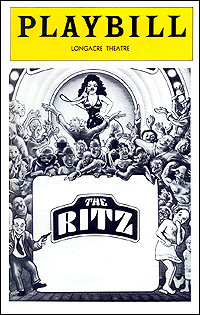
Playbill from the '70s Longacre production
I never saw the original, but I did go to the film adaptation of The Ritz, directed by Richard Lester, when it came out in '76, the year after Rita Moreno won a Tony for her portrayal of bathhouse cabaret chanteuse Googie Gomez, the play's only juicy role. The film's main plus, other than a manic Moreno, is that its plot and dialogue assume that "gay" is out there, sort of normal -- albeit sex-centered, albeit despised. That alone made it brave and worthwhile. Otherwise, the movie, which I recently borrowed from my local library's video collection, huffs and puffs and stays put.
By most reports, the play was a fey Feydeau farce then, and it's the same now. In spite of some worthy trouping and the usual suburban assortment of bare male buttocks, history has made it worse. Dated. Sad. Unless there are big bucks to be made, why go to the trouble to produce it?
Yet...here's part of what Pulitzer-winning critic Richard Eder wrote about the film when he reviewed it more than 30 years ago for the New York Times:
But if the farce suffers mainly from wearing lead shoes, the homosexual gimmick suffers from something more serious. To have a tolerance, or even an acceptance of homosexuality doesn't rule out having an underlying physical distaste for it. Inevitably perhaps, the camera emphasizes the physical element far more than it was emphasized on the stage. To put it bluntly, it shoves up too close--for most of us, I think--too much pale flesh organized around unshared intentions. There are simply too many male homosexual stomachs, arms and faces at too short a range.
That, good readers, is what we were up against. The diagnostic-sounding term "homophobia" doesn't quite capture the writer's marble-pedestal throne tone as well as the unpleasant underlying scent of us-versus-them anxiety. Keep those invert tummies at arm's length! And Mr. Eder was by no means the worst.
I'll take this opportunity to climb onto my own slippery pedestal and play historian, with a refresher about the time the gay baths crossed over. Did you see the photo at the top? It shows a black, deco-lettered towel sold by Bloomingdale's that celebrated an Oct. 4, 1973 performance and RCA recording of Eleanor Steber: Live at the Continental Baths.
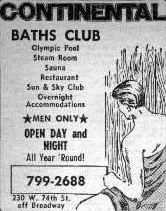
The 20,000-square-foot Continental, opened in 1969, was located in the basement of the ornate Hotel Ansonia on Manhattan's Upper West Side. It quickly lost its gay anonymity and became a destination where slummers could join the lucky, uninhibited regulars (a la Harlem in the '20s) to hear Peter Allen, Cab Calloway, Melba Moore and the young Bette Midler, Honolulu sunlight still in her hair. Midler, as you probably know, performed with accompanist Barry Manilow, who, in keeping with what was proper, wore a flimsy white towel at the piano.
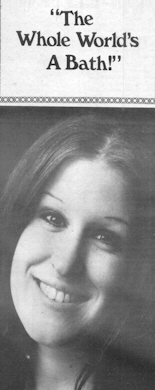
Diva-to-be
Madame Steber, though, in chiffon and diamonds, draped a black towel around her ample waist. The formidable diva offered Mozart, Charpentier, Puccini and more "while boys yell 'Brava!' " and "Mrs. Leonard Bernstein, Suzy, Patrice Munsel, a lot of Metropolitan Opera stars and half of New York society looked on." (This reported not by Eder at the paper of record, but by Rex Reed at the Daily News.)
That quite telling and optimistic bit of gay -- and opera -- history can be heard online via parterre box, the queer opera zine. In his live concert introduction, bathhouse owner Steve Ostrow says that when Steber asked for quiet during rehearsal, she was immediately obeyed: "You could have heard a towel drop."
He also declares to his audience that the event is taking place "in a house of love." He means it. Only a few titters can be heard in the background.
Postscript: The Village Voice, where I worked from 1979 to 1995, recently put out a 50th-anniversary issue. From my hundreds of pieces, the editors chose this.
For an automatic alert when there is a new Out There entry, email jiweinste@aol.com.

View of Savannah, Georgia, 1734. The hotel we stayed at was on the uncity side of the river, between the trees. (Perry-Castañeda Library Map Collection, University of Texas.)
A Moment in Savannah
William Blake saw the world in a grain of sand, but I saw a slice of Savannah in a grain of rice.
My usual Washington Square is in New York's Greenwich Village, rescued by angry neighbors from the egomaniacal traffickings of Robert Moses. But this smaller, manicured Washington Square, eerily quiet at dusk, is in lush Savannah, Georgia, and the site of a genial event welcoming the American Association of Sunday and Feature Editors. Savannah's green and pleasant squares, emeralds in urban settings, define the historical center of the new land's first planned city.
At one food table, we were offered -- with the easy hospitality that turned out to be as common here as moss on live oaks -- something chef Christopher Hewitt of the Olde Pink House calls Southern Sushi. The shtick is that rice is replaced by grits. (Which surrounds smoked shrimp salad -- plenty of wild Georgia shrimp hereabouts. Then the roll is battered, covered with panko and coconut crumbs, fried, and drizzled with soy reduction and wasabi vinaigrette.)
This struck me as odd. One would have thought that rice was at least as Southern as coarse cornmeal, considering it was Georgia's first staple crop and the source of Lowcountry fortunes until its farming moved southwest at the 19th century's end. Has sushi made rice "culturally Japanese"? Polenta hasn't yet made grits Italian.
The caterer placed small dishes of that grushi upon the shelves of a tall bookcase on the lawn for us to take -- a novel, yet strangely disconcerting, way to serve.
Later I read that in Savannah, "rice with fish is unheard of." Georgia-kosher?
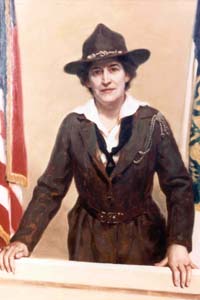
Portrait of Juliette Gordon Low ("Daisy") by A. Jonnieaux
House Tour
What was that woman doing at our little party dressed in a dun-colored military outfit that looked almost a century old? She chatted away assuming I would know that Girl Scouts founder Juliette Gordon Low -- familiarly known as Daisy, a decent painter and sculptor, the woman she was impersonating -- was a Savannah notable. The actress obviously loved her city, and if the elaborate costume was an instrument of torture in the steam-bath heat of the evening, she didn't let on.
She also didn't mention Daisy's fateful grain of rice.
A taxi driver previously told one of our group's editors that if she had one house tour to take, it should be Daisy's birthplace. So one afternoon we walked to the Victorianized Regency manse at 10 East Oglethorpe Avenue, paid our fee, and got a snappy room-by-room narrative from a guide who turned out to be a journalist herself.
In front of a dingy painting of the somewhat ordinary-looking young woman, we tourists were taken aback by this unexpected detail: At Daisy's wedding to the well-heeled heel William Mackay Low ("who never worked a day in his life"), a grain of rice tossed at the just-married couple became lodged in the bride's ear. An English honeymoon was curtailed because her ear became infected, and a doctor back home trying to remove the rice punctured her eardrum. Already deaf in the other ear (another wretched doctor), Daisy completely lost her hearing -- and her husband.
After that, the rest of the house, and her inspiring story, were dust.

New Museum
The light that streams into the glass-covered atrium would flatter the faces of any betrothed couple who walked down the broad, party-friendly staircase of Moshe Safdie's Jepson Center for the Arts, which opened in March 2006.
One could predict a battle to build anything obviously new within this city's core, and indeed it took years of back-and-forths with the Savannah Historic District Board of Review for the hoary Telfair Museum of Art to get the go-ahead for its contemporary branch. The resulting 64,000-square-foot space, a civic victory, must glow like a beacon of modern refreshment at night. But during the day I'm afraid the white-limestone and cement side walls look makeshift; some of that outdoor limestone, the color of dirty rice, is already cracking.
Local, Local, Local
Two smart friends-of-friends living in Savannah sent us to a polished, too-new-for-guidebooks place in a defunct deco bank, chic as can be. The chef at Local 11 Ten strives to use local ingredients, but without the anchor of local recipes; I am afraid I'm becoming what is known as a "locavore." With one slight exception, which has to do with geometry and calculus, everything satisfied -- the prosciutto-wrapped rabbit especially hopped into our collective maw. Flat, green pole beans that accompanied the "100-mile" flounder entrée (one 100-miler is offered daily, cooked from ingredients obtained within that distance) became my night's winning flavor.
Savannah is now a college town, because the Savannah College of Art and Design, known as SCAD, had the marvelous -- and cost-effective -- idea to rehab dozens of unused city buildings from many periods in a panoply of styles and make its campus an exercise in architectural Scatter Art.

A SCAD student residence. Still 28 flavors?
I mention this because the chances are better than good that any Savannah waiter -- and bartender -- under 40 years of age is or was a SCAD student.
A previous Out There posting had convinced an otherwise decisive, vodka-loving member of our party that all her subsequent martinis would be of the gin persuasion. So, with permission, I ordered three for the table made with Hendrick's, the Scottish almost-novelty gin that tastes of cucumber and rosewater. Yes, straight up. (Perhaps it's my taste in friends, but I have never met anyone who wanted a martini on the rocks.)
The waiter appeared with the three sloped glasses. None was full; all were at different levels. Mine was at half, but I didn't complain, because carping cools the warmth of any social occasion, especially one with knives and forks. But I did whisper that in the case of a martini in its proper vehicle, a half-full glass actually contains less than half the volume. ("The top inch is half the drink" goes the cocktail cliché.)
Find Finally Found
Savannah karma, however, led us to church and the antidote to any deficit. The United House of Prayer for All People is a short drive from the city's strollable center. An annex to the church is a cafeteria-style restaurant called the Masada Café (2301 W. Bay Street, 912-236-9499), open for lunch and early dinner. I think you can see this coming, and I must beg forgiveness for rubbing a certain kind of ecstasy that you cannot immediately share into your internet face.
The Southern food at Masada Café was the best I have ever had, the best I have ever imagined.

Rib smokers on church patio
How lucky we 10 editors, writers and mates felt, even more so because the ribs (from three smokers in the patio outside) are served Saturdays only -- and today's Saturday. Every great pork rib out there knocks the previous rib from the barbecue pantheon. This chewy, smoky one will hold its place for quite some time.
I know that when life offers pleasures such as these, you order twice as much. (My double-lunch bill was $14.) The patient server pointed to or named the choices: ebony oxtail stew, smothered chicken, baked chicken, fried chicken, fried catfish, those ribs (I know I'm leaving something out); mac and cheese, corn on cob, dressing, field peas (beans), fried okra, green beans. Later, right from the oven, pumpkinish sweet potato pie. Refills of iced tea, sweet or the outsider kind. Authentic hospitality from every member of the staff.
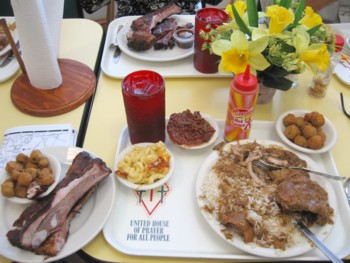
A light lunch (cafe photos by Janet Grimley)
I greedily sampled and charitably passed around everything -- except the dark oxtail, which no one ordered, thinking someone else would. Foolish! The definitive fried chicken made the skin-or-meat dilemma impossible to solve. Tiny ruddy field peas had a delicate vegetable soul, no matter how savory their surroundings. But the center of my meal was surprising: Over and over, beyond hunger, I scraped and spooned the succulent rich gravy from the smothered chicken onto red rice.
Red rice? Classic Savannah, onion and green pepper, thyme, maybe celery and garlic, fried in bacon fat; tomato and rice added, simmered, then baked. Not showy at all. Merely unforgettable.
For an automatic alert when there is a new Out There entry, email jiweinste@aol.com.
Blogroll
AJ Ads
AJ Blogs
AJBlogCentral | rssculture
Terry Teachout on the arts in New York City
Andrew Taylor on the business of arts & culture
rock culture approximately
Laura Collins-Hughes on arts, culture and coverage
Richard Kessler on arts education
Douglas McLennan's blog
Dalouge Smith advocates for the Arts
Art from the American Outback
For immediate release: the arts are marketable
No genre is the new genre
David Jays on theatre and dance
Paul Levy measures the Angles
Judith H. Dobrzynski on Culture
John Rockwell on the arts
Jan Herman - arts, media & culture with 'tude
dance
Apollinaire Scherr talks about dance
Tobi Tobias on dance et al...
jazz
Howard Mandel's freelance Urban Improvisation
Focus on New Orleans. Jazz and Other Sounds
Doug Ramsey on Jazz and other matters...
media
Jeff Weinstein's Cultural Mixology
Martha Bayles on Film...
classical music
Fresh ideas on building arts communities
Greg Sandow performs a book-in-progress
Exploring Orchestras w/ Henry Fogel
Harvey Sachs on music, and various digressions
Bruce Brubaker on all things Piano
Kyle Gann on music after the fact
Greg Sandow on the future of Classical Music
Norman Lebrecht on Shifting Sound Worlds
publishing
Jerome Weeks on Books
Scott McLemee on books, ideas & trash-culture ephemera
theatre
Wendy Rosenfield: covering drama, onstage and off
Chloe Veltman on how culture will save the world
visual
Public Art, Public Space
Regina Hackett takes her Art To Go
John Perreault's art diary
Lee Rosenbaum's Cultural Commentary
Tyler Green's modern & contemporary art blog
